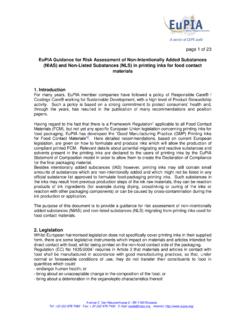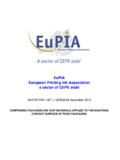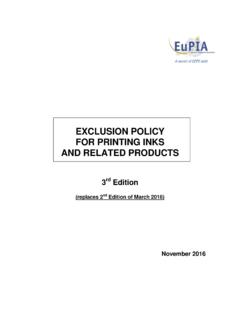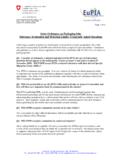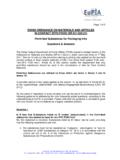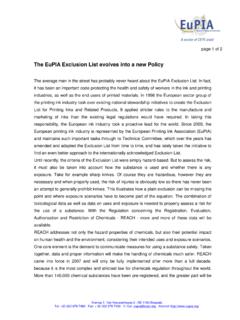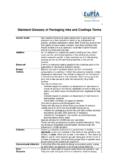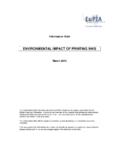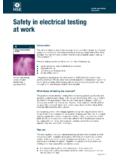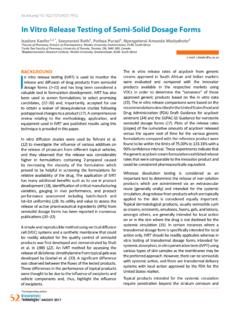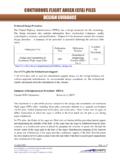Transcription of EuPIA Guidance on Migration Test Methods for the ...
1 Page 1 of 15 Avenue E. Van Nieuwenhuyse 6 - BE-1160 Brussels Tel: +32 (0)2 676 7480 - Fax: + 32 (0)2 676 7490 - E-mail: - Internet: EuPIA Guidance on Migration Test Methods for the evaluation of substances in printing inks and varnishes for food contact materials Table of Contents 1. Introduction .. 2 2. Definitions .. 3 3. Recommended Methods .. 4 Worst case calculation and Migration modelling .. 4 Justified deviations from the recommended Methods .. 4 Preparation of test 5 Printing and drying of the test samples .. 5 Storage / conditioning of samples .. 6 Migration testing .. 6 Selection of Migration cells .. 6 Selection of testing 6 Analytical identification and 8 Targeted analysis (IAS/NLS/NIAS) .. 8 Non-targeted analysis (NLS/NIAS).
2 9 4. References .. 12 Annex A: Calculation of maximum possible Migration ; formula and example .. 13 Annex B: Calculation of maximum possible Migration : Digital printing applications .. 14 Annex C: Storage/Conditioning of print samples .. 15 page 2 of 15 Avenue E. Van Nieuwenhuyse 6 - BE-1160 Brussels Tel: +32 (0)2 676 7480 - Fax: + 32 (0)2 676 7490 - E-mail: - Internet: 1. Introduction This EuPIA Guidance document is to be used in conjunction with food packaging regulations to help select appropriate testing Methods for the evaluation of the Migration of components of packaging inks applied to the non-food contact surface of food packaging materials and articles intended to come into contact with food. Testing Methods for the evaluation of direct food contact applications will be dealt with in a separate document.
3 This document should be read in conjunction with other EuPIA documents on printing inks for food packaging, for instances the EuPIA GMP [1] and the EuPIA Guidance on the Risk Assessment of NIAS and Non-Listed Substances [2]. The ink itself shall not be tested as such, since its composition may change during the printing process. In addition, the substrate greatly influences the Migration properties of the components of the ink. Regulation (EC) No. 1935/2004 requires that the finished article for food contact materials must be tested and / or evaluated under real conditions of use. Screening tests can be based on experimental-analytical testing Methods or on theoretical Migration estimations via calculation or Migration modelling.
4 Testing the inks, coatings and varnishes with model systems and conditions can only be considered as a screening tool and should be used only when the worst-case calculation or Migration modelling cannot be conducted due to missing information, or the results of these calculations exceed the specific Migration limits (SML) associated with components of the inks, coatings and varnishes. The specific Methods of Migration testing and analysis are described either in EU Regulations [3] on materials and articles in contact with foodstuffs or international Standards [4] [5] [6], with the exception of the preparation of printed samples. For this purpose, substrates and simulants are recommended to check the Migration behaviour of components of packaging inks, coatings and varnishes under worst-case conditions.
5 The draft JRC guideline on compliance testing [7] states: As a matter of principle, screening approaches need always to be at least as conservative as the verification method. Therefore, test conditions which are at least as severe, should be applied. For an estimation of Migration conservative theoretical considerations which overestimate Migration are needed. As a logical consequence, screening tests can only be conclusive in that they demonstrate compliance but they cannot demonstrate non-compliance. In the event of exceeding a Migration limit by screening, compliance may be checked then by using a more appropriate verification test using food simulants or even foodstuffs. Since, from experience, screening results will be in most cases conclusive concerning positive compliance declaration, screening tests offer advantages over verification Methods with regard to time and costs.
6 The JRC guideline provides detailed information on compliance testing, however, it is only applicable to plastic materials and articles in the scope of this regulation [3]. In the absence of harmonised regulations on other Food Contact Materials (FCMs) the conditions used in the Plastics Regulation are often also applied to non-plastic FCMs. However, plastic simulants and/or conditions may cause physical damage or changes to the non-plastic FCM leading to erroneous results. This is also true for printing inks (see below). Hence, testing conditions better suited to the specificity of each FCM needs to be proposed [8]. This document is aimed at providing specific Guidance for printing inks for FCMs. page 3 of 15 Avenue E.
7 Van Nieuwenhuyse 6 - BE-1160 Brussels Tel: +32 (0)2 676 7480 - Fax: + 32 (0)2 676 7490 - E-mail: - Internet: 2. Definitions Printing Ink The term printing ink , or in short just ink , in this paper includes: (a) Mixtures of colourants with other substances which are applied on materials to form a graphic or decorative design together with (b) Other coloured or uncoloured overprint varnishes/ coatings or primers which are normally applied in combination with (a) in order to enable the printed design to achieve specific functions such as ink adhesion, rub resistance, gloss, slip/friction properties Printing inks do not include coatings which are applied with the prime objective of enabling the material or article to achieve a technical function such as heat sealing, barrier, corrosion resistance, as opposed to a graphic effect, even though they may be coloured.
8 Migration In the printing industry, when we refer to Migration this concept in its simplest form is the transfer of components from the FCM into the foodstuff itself. Transfer of printing ink components from a printed packaging material or article into food or food simulant may occur either directly as Migration through the substrate, via contact to the reverse side in a reel or stack (known as set-off Migration ) or by gas phase transfer. As there are several different mechanisms of Migration taking place, the assumption that the degree to which a printing ink component will migrate directly relates to the component s molecular weight cannot be relied upon. Smaller molecules will likely migrate more readily than larger molecules, and molecules with a mass greater than 1000 Daltons (or 1500 Daltons for Fluoropolymers) are generally considered to be of no concern as they are too large to be absorbed from the gastro-intestinal tract.
9 However, there may be exceptions where a substance with a molecular weight of greater than 1000 Daltons will readily migrate and accordingly will have a Specific Migration Limit (SML) which will limit the acceptable level of Migration . Intentionally Added Substances in printing inks for FCMs (IAS) [2] IAS in inks are all chemical substances which are intentionally added in the production and use of the printing ink. They have an intended and specific function within the final ink and without which the performance of the inks would change. These substances may be added as single components or as mixtures of various substances. The term use of raw materials or substances in inks in this paper means always that these raw materials or substances are added intentionally.
10 Non-Intentionally Added Substances in printing inks for FCMs (NIAS) [2] NIAS are all chemical substances which are not IAS and do not have an intended and specific function within the ink formulation. Such NIAS may come from impurities in used raw materials from former production steps or could be created due to contamination in ink production or handling or during the application process of the inks ( unintended side reactions during crosslinking, curing, drying or decomposition). page 4 of 15 Avenue E. Van Nieuwenhuyse 6 - BE-1160 Brussels Tel: +32 (0)2 676 7480 - Fax: + 32 (0)2 676 7490 - E-mail: - Internet: Non-Listed Substances (NLS) [2] NLS are intentionally added substances, which are not required to be listed.
